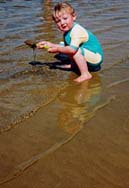Massachusetts town shudders after study details cancer risk
Neil MacLennan remembers the fun he and his friends had as boys playing in the funny candy-colored swamps and ponds near the ballfields catching frogs, wading in to retrieve fly balls, jumping in to cool off after practice.

"It was just what we did. You just wouldn't think about it," recalls MacLennan.
More than 20 years later, MacLennan, now 34, is thinking about it a lot, and worrying.
State health officials recently released the results of a seven-year study that confirmed what many in MacLennan's hometown suspected: Children who swam or waded in the water near a now-closed dye manufacturing plant run an increased risk of cancer.
Investigators interviewed 1,387 residents who were 10 to 18 years old between 1965 and 1985 and found 73 cases of cancer and eight cancer-related deaths. About two-thirds of the cancers were diagnosed before age 35, and many involved rare forms of the disease.
State health officials are suggesting that people who played in the water check with their doctors about whether they should get screened for cancer.
Some scientists have questioned the broad warning and say the findings may be unreliable. They note that some of the study's conclusions were based on decades-old recollections of childhood play habits, and involved small numbers of people.
Still, the study has many people who grew up in Ashland, a town of just under 15,000 about 22 miles (35 kilometers) west of Boston, shuddering to recall what they did as children in the 1960s, '70s and '80s.
Back then, children and many adults in Ashland did not worry much about the brightly colored blue, purple and red water in and around the 35-acre (14-hectare) site owned by Nyanza Inc., which released manufacturing waste containing such substances as mercury, chromium, lead and cadmium into unlined lagoons and nearby streams.
"To be 7 or 8 years old and walking through a purple puddle was pretty cool," said Erin McGrath, 34, who remembers almost all of the boys she grew up with jumping or wading into the water.
Residents recall stories of youngsters coming home with their hands and clothes stained with dye.
"People in the town will tell you they knew what color of dye was being made on almost any day of the week because the brook down the street would turn purple or red, or whatever color they were making dye for that day," said Suzanne Condon, the assistant public health commissioner who oversaw the study.
The plant site was run by various textile companies beginning in 1917. Nyanza operated it as a dye manufacturing plant from 1965 until the company went bankrupt in 1978. The site was added to the federal Superfund list in 1983, and the Environmental Protection Agency spent $46 million (Ђ36 million) cleaning it up.
It is unclear whether there is anyone the cancer victims can sue, now that Nyanza is out of business. But the EPA, as part of the cleanup, did collect about $13 million (Ђ10 million) from the estates of people who owned and operated the company and its successors.
MacLennan was one of five adolescents and young men in Ashland who developed sarcoma, a rare type of soft-tissue cancer, in the 1980s and '90s. The five played Little League together and were all within a year of each other in school. Three of them died in their teens and 20s. MacLennan, who was diagnosed at 14 after he went to see a doctor about a lump on his foot, beat the cancer with chemotherapy and radiation.
McGrath watched her boyfriend, David Keddy, die at age 20. Six years later, she served as a pallbearer at the funeral of another close friend, Kevin Kane, who died in 1998 at 26. It was Kane who researched the cancer cases and persuaded state health officials to launch the study, but he died before it even began.
"Our friends started getting cancer in eighth grade," McGrath said. "We were young, and we shouldn't have to go through that."
Health officials said the study showed that people who waded or swam in certain pools on or near the Nyanza site were two to three times more likely to get cancer than those who had no contact with the water. People with a family history of cancer were as much as four times more likely to get the disease.
Reginald Mimms, 48, a lifelong Ashland resident who is now a member of the town's board of health, recalls practicing for the track team by running along a path that went from the old Ashland High School through the Nyanza site. Many children cut through the woods surrounding the plant to get home from the school, he said.
The cancer study "has scared a lot of people," he said, reports AP.
O.Ch.
Subscribe to Pravda.Ru Telegram channel, Facebook, RSS!





